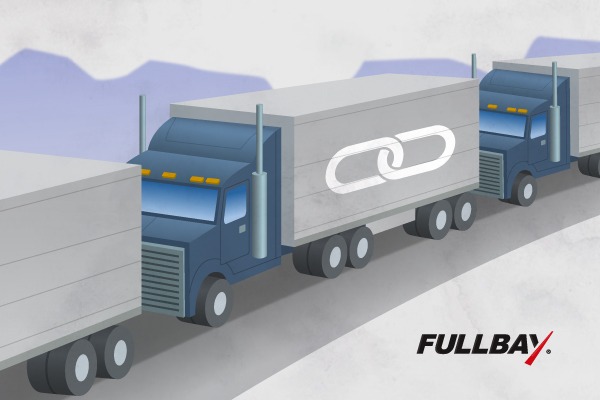4 Things You Need to Know About Truck Platooning

Safety and profits are the two biggest concerns for single-truck owner-operators and massive fleets alike. That’s why everyone sits up and takes notice when new ideas that promise to increase both hit the news. Truck platooning is one such notion, built around using cutting edge technologies. People who support the concept say it’s a great way to make big rigs more efficient in the most important areas—fuel, time, and labor. With more testing, though, fewer in the industry remain positive about platooning. The trials support truck platooning benefits. However, it seems that those benefits require specific conditions to make platooning efforts worth it. Wondering if the reality can live up to the hype? There are four things that drivers and fleet managers should consider before deciding whether platooning is right for them.
What is Truck Platooning?
Truck platooning is similar to the idea of convoys. When trucks platoon, two or more semis travel together. But using the latest driving support systems is the fresh twist that truck platooning puts on the age-old concept. Smart tech links the trucks so they can drive in tandem, closer together, and communicate in real time. The tech that connects the vehicles like an invisible chain is the basis for truck platooning benefits.
Newer and older trucks already have the tools that make platooning possible. It’s the communication, GPS, sensors, cameras, and other gear associated with self-driving semis. Currently, all the trials still use a driver in each semi in a platoon. However, the driver in the lead semi is the one who does most of the actual driving. When he slows down or brakes, the tech causes the trucks behind him to slow down or brake all together. That means less reaction time, so required following distance drops, too.
Will platooning open the path to completely self-driving fleets? If the trucking industry fully embraces platooning, that will be a likely outcome. Still, at least for the time being, platooned trucks will have human pilots. Additionally, there will be times when a platoon is made up of semis from different fleets and/or single owner-operated semis. In those cases, there will typically be a human driver on board each truck.
Potential Truck Platooning Benefits
The testing phase of platooning is promising. The results have yielded a range of truck platooning benefits that got a lot of people excited at first. For instance, connected driving reduces driver reaction time to nearly zero, reducing human error along with it. That means increased predictive driving and safer conditions for truck drivers as well as others on the road.
Then there’s the efficiency factor. Trucks that can travel so closely together—with as little as 65 feet between them—will use less fuel. It’s estimated that platooning can reduce fuel use by about 4 percent. Truck platooning is supposed to improve traffic flow, reduce traffic jams, and make more effective use of the roadways. That element alone should optimize America’s transport system. What’s more, only the lead driver in a platoon is actively driving. That leaves drivers in the semis behind the leader free to use the time for other tasks.
In addition to better safety and efficiency, truck platooning benefits also include a clean element. When trucks travel close together at a constant speed, they don’t accelerate and brake as much. That results in using less fuel. Estimates say platooning could reduce CO2 truck emissions by as much as 10 percent.
Platooning may sound like a great idea for fleets, but what about the single-truck business? Proponents say that everyone can reap the rewards of platooning. Trucks and drivers heading in the same direction just get together and make a plan for taking turns on being the lead.
The Story Behind the Resistance
With so many likely truck platooning benefits, you might wonder who could object to the plan. Turns out, plenty do. And more are taking a step back as they look at everything that’s involved in making a platoon work right. It all boils down to a concept that relies on consistency working in a world that is anything but.
Start with linked driving. Things like brake wear and fluid levels can affect reaction time. That’s why, for the trucks to respond properly to the lead driver’s actions, all the trucks should be on the same PM schedule. That can be a huge issue if different fleets want to try to platoon together. Also, although platooning provides overall fuel savings, the actual per-truck savings depend on what position that truck is in. How do you assign positions to trucks from different fleets when some will get better fuel savings than others?
Plus, even for fleets and drivers open to platooning, the chances to take advantage of the benefits are limited. Not all U.S. roadways are available for platooning. Right now, there are only 17 states that offer the special conditions needed for platooning. That makes only about 45,000 miles available for trucks to platoon on.
Non-commercial traffic is another issue. When there are other drivers on the road, platooning trucks can’t keep passenger cars from darting between them. But that results in a break in the tech link that is the basis for all the truck platooning benefits. Sure, the lead driver can restore the connection. But that can take time, and even a short break—as few as 15 to 20 minutes—can cancel out the fuel-saving benefits of platooning.
Should Everyone Get On Board With Truck Platooning?
Stacking up all the facts side-by-side may not make a decision about truck platooning any easier. There’s even a split among the “big” guys. Daimler, the largest truck maker in the world, was excited about truck platooning benefits at first. But, over the last few years, that excitement has waned. As recently as January 2019, the big “D” announced their intention to drop platooning.
On the other hand, Peloton and even the U.S. Army still have enough confidence in truck platooning benefits that they’re leading the way in continued testing. Peloton is concentrating on everything that makes platooning work—the communication, hardware, software, and cloud computing—and have patented their methods.
The Army feels that platooning is an idea worth pursuing. The view is, even though it isn’t a solution for everyone, there are plenty of opportunities where it will work well. Specifically, the military is looking at combat situations, where fewer soldiers’ lives would be endangered in a platooning situation. However, there are also opportunities in the civilian business sector. When two or more trucks are headed in the same direction at the same time, for example. True, the stars don’t align like that all the time. But, when they do, it might make sense to take advantage of truck platooning benefits.
Is platooning right for your fleet? Only you can make that call, based on the available information. It may take as long as 5 years for platooning to fully kick in. By then, hopefully, there should be even more statistics and data. Extra info could make the decision easier. Who knows? Additional technology advancements could increase the already promising truck platooning benefits. One thing is certain: if future testing shows platooning improves safety as well as raises profits, it’s a solution that will interest everyone.

